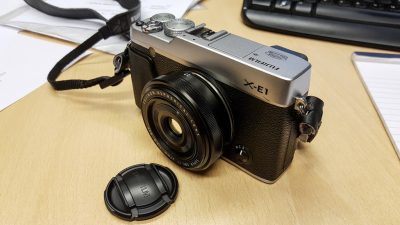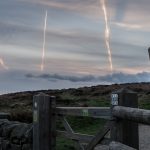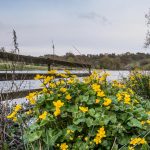This post is a bit late as I aquired my first Fuji X-E1 in April 2017.
I will start this look at the Fuji X-e1 with a bit of personal history.
My first remembered encounter with a camera was when I was preteen and the camera was a box camera with a piece of tracing paper over the back in place of the film enabling me to see the world upside down and back to front …….this got me hooked. I went through a series of consumer cameras Instamatic’s etc.. eventually ending up in the mid 1970’s with a Praktica Super TL2 and a Minolta Autocord TLR both of which served me from then to about 2008.
The Praktica had a built in light meter its only electronic aid………..you had to get the needle in the circle to get correct exposure.
From 2008 I have had too many cameras to mention all from the new digital age ending up with canon kit a canon 40D (crop) 5D (Full frame) and a mirrorless EOS-M (no viewfinder).
All the cameras I have (more than mentioned above) all work fine they all have “special features” and are better or worse in differing situations…………no camera is good for every situation much like no single hammer is the do everything hammer.
The camera I have spent most time with over my lifetime was my Praktica Super TL2 with its fancy  Built in meter where I had to drive the film, control the aperture shutter speed and focus all by hand and by virtue of this compared to todays cameras meant I was an integral part of the image capture machine where a modern DSLR the machinery does all the work and you just point it in the right direction
Built in meter where I had to drive the film, control the aperture shutter speed and focus all by hand and by virtue of this compared to todays cameras meant I was an integral part of the image capture machine where a modern DSLR the machinery does all the work and you just point it in the right direction  to be honest depending on the kit you have you can exercise as much or as little manual input as the camera will allow.
to be honest depending on the kit you have you can exercise as much or as little manual input as the camera will allow.
Now eventually to the Fuji X-E1 this camera looks very much like a 1970’s Rangefinder camera with its black and satin chrome look and sporting similar external controls, I did find it very easy to get familiar with the camera controls in a very short time and can operate the camera without the need to look at the controls and can keep my eye on the viewfinder while making the adjustments. Using the 27mm pancake lens you have to use the command dial to adjust the Aperture as the lens has no aperture ring.
The X-E1 looks great marrying the looks of a classic 1970’s camera with todays technology so for me the best of both worlds.
Using the X-E1 I find is straight forward and being able to control the aperture and shutter speed from controls on the exterior of the camera is much easier and quicker than hunting through menus although the Q menu on the Fuji is easy to use to make adjustments or to load a custom preset, the EVF (Electronic View Finder) I find a real boon as there is proper diopter adjustment for those of us who need spectacles enabling me to see the menus etc in the viewfinder as sharp as sharp this is a big plus compared to my EOS-M which has no viewfinder and relies on the rear screen which is OK to a point….fails on sunny days and I need to mess around with my spectacles to be able to see the screen plus holding a camera with a viewfinder inherently is a more stable configuration than holding the camera at arms length.
When I bought the camera body I also ordered an adapter to enable me to use other than the Fuji XF lenses and this works really well the camera is set to shoot with no lens as the non fuji lenses have no electrical connection to the body and require focus and aperture control to be handled manually on the lens no problem with any old manual lens but I cannot adjust the aperture and have to use my Canon EOS lenses with the aperture set wide open. Accurate focusing manually is simple using the command dial you can zoom in to get precise focus.
I have not had much opportunity to use the system in anger but as time goes on I am sure my attempts at capturing images will be posted on here flickr and elsewhere.
I have since donated the pancake lens to one who will enjoy it more.
A few images taken with the 27mm pancake and a samyang 12mm



